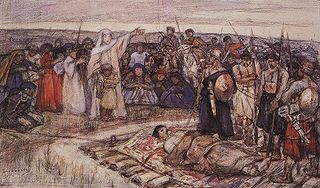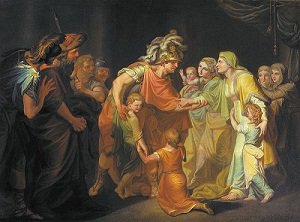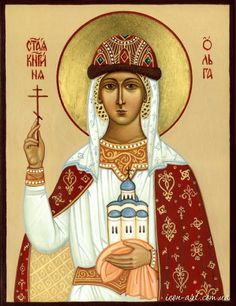Saint Olga, Queen of Kiev

Some people regard history as a matter of memorizing facts and dates, but I’ve always thought of that as a decidedly narrow view. Narrow and often misguided, in fact, as those years are often a controversial matter in and of themselves. A case in point is the “Greek Dark Ages”, a three or four hundred year period where Greek civilisation apparently entirely collapsed, before recreating itself. Some historians argue that this period of time never actually existed, but is simply a discontinuity between the calendars used to date the events of the period. A similar, though less hotly debated, example is that of Olga of Kiev.
Olga was born, according to the generally accepted dates, in 890 AD. She was married in 903 AD, and gave birth to her first son in 944 AD. The forty year gap there would be where the controversy comes in – it’s related to the believed date of her husband assuming the throne of Kiev, which many scholars now think may be down to an error in dating. In fact the events of her life make a lot more sense if you assume that she was born around thirty years later, as posited by the French historian Constantine Zuckerman. The contrary opinion is that of the Primary Chronicle, a Russian history written in the 12th century and the closest to a primary source we have on the early day of the Kievan Rus’. It gives the date of Olga’s birth as 879 AD, which is highly implausible. Of course, it was written three hundred years later, when Olga had become legendary, so they may have regarded her giving birth at age 65 to her first child as merely part of that legend, but it does stretch the boundaries of credibility.
What we do know about Olga is that she was a Varangian, one of the descendants of Viking mercenaries who lived within Kievan Rus’. This loose tribal confederation was the predecessor of moder Russia, Belarus and Ukraine in a similar way to how modern Germany is the descendant of the Holy Roman Empire – it’s not a clean line, but the heritage is clear. Kievan Rus’ was founded by Rurik, who was also a Varangian, some time in the 9th century AD. He died, apparently in 879, and was succeeded by his son Igor. Since Igor was a child a regent was in place for the early part of his reign, but in 941 he brought the Rus onto the world stage when he went to war with the Byzantine Empire. It is from their records that the “Primary Chronicle” gets the date for his accession to the throne, and where the uncertainty in chronology arises. [1] Certainly there are no records of him elsewhere prior to this, and it may be that the later author of the Chronicle misinterpreted these Byzantine sources.

It does seem that Olga was very young (around 13) when she married Igor, anyway. We know that they had at least one child, a boy named Sviatoslav. (Well – some historians think that Sviatoslav was actually her grandchild, and that her actual son, named Volodislav, died shortly after the boy’s birth. This would answer some questions, but introduce even more.) And we know that she was widowed in 945 AD, when her husband Igor was murdered by a group of his nominal subjects, the Drevlian tribe. A Byzantine chronicler named Leo who actually met Sviatoslav much later recorded that Igor’s mistake was in trying to collect a tax from the tribe too soon after he collected the previous one, perhaps to finance another offensive against the Byzantines, so they decided to rebel. Other accounts have it that they paid their tax to Igor’s vassal Sveneld, and that Igor had no right to tax them directly. Where the sources agree is that they killed Igor, according to Leo by tying him to two tethered saplings and allowing them to spring apart and dismember him. And then, in what would prove to be a bit of a mistake, they sent envoys to Olga proposing marriage.
Sviataslov was only three years old at the time, but the chronicle states that the law of the Rus tribe was that he would inherit his father’s rule, with Olga standing as regent until his majority. The Drevlians proposed to have their leader, named Mal, marry Olga and take over the leadership of the tribal confederation. Olga gave the matter some consideration, then had the messengers buried alive. She followed up by sending her assent to the proposal, but said that she would need to have the most distinguished members of the tribe come to Kiev and escort her on her bridal journey. When the men arrived, she offered them a refreshing bath. Then she locked the bathhouse and set it on fire. She invited the Drevlian soldiers to attend a mourning feast at her husband’s grave. Once they were drunk, her men fell on them and slaughtered them. Then, with her army at her back, she turned up at the gates of Iskorosten, the Drevlian capital. She said that with their leaders and warriors dead she was prepared to spare them, in exchange for a tribute of three pigeons and three sparrows from each house. When the birds arrived she had her men attach smoldering sulphur to each of their legs, and then set them loose. They flew back to their homes, and set the roofs and trees of the city alight. As the Drevlians fled, Olga had her men attacking, killing some and enslaving others. Thus she took her revenge.

The preceding paragraph is all legend, of course, but there does seem to be some truth to it. It’s true that Olga crushed the Drevlians so thoroughly that their tribe barely lasted another few generations. The remainder of her regency was marked by successful military conquest, a change in the taxation system (in order to avoid the danger Oleg had inadvertently put himself in) and improved diplomatic relations with Byzantium. Olga herself visited Constantinople twice, once in 945 and once in 957. On one of these two trips she converted to Christianity. There were Christians among the Rus before this, though they were often persecuted. These visits appear in both the Byzantine records and the Rus Chronicle, allowing us to tie the two chronologies together. One story in the Chronicle, but not the Byzantine records, has it that on her visit to Constantinople the Emperor Constantine VII became besotted with her and tried to make her his wife. However Olga tricked him by having him take on the role of godfather in her baptism, then reminding him that by church law this would make any relationship between them incest. Of course another hitch would have been that Constantine was already married. Olga actually took on the name of his wife (Helena) as her baptismal name.
Olga tried to spread Christianity among the Rus, but she met with limited success. Her son Sviatoslav was afraid that if he converted he would lose the loyalty of the tribes, and Olga could not convince him to relent. [2] The bishops she had asked Constantine’s successor Otto to send were driven out of the country by the tribal leaders. Her one notable convert was her youngest grandson, Vladimir. In 964 Sviatoslav reached his legal majority, and Olga stood down from the regency. With Byzantine support he set out on a mission of conquest, attacking the Khazar lands to the east. He sacked the major Khazar cities and established dominion over the region, becoming a major power. When the Byzantines then asked him to help them conquer the Bulgarian lands that lay between them, the Byzantines soon realised that he was clearly planning to claim all the land up to their border. In the hopes of driving him off, in 968 they bribed the Pecheneg nomads who lived on the steppes bordering Kievan Rus’ to lay siege to Kiev and force him home.

At the time Olga was in the city, along with Sviatoslav’s three sons. One of Sviatoslav’s generals, a man named Pretich, was in the area of the city. He set up camp across the river from it, but realised he lacked the men to break the siege. Meanwhile within the city the people were suffering. They had been caught with depleted supplies, and Olga decided they needed to let Pretich know how serious things were. A young boy who spoke fluent Pecheneg escaped the city, and moved through the enemy camp pretending to be searching for a lost horse. Eventually he made his way to Pretich’s camp. Once the general knew how bad things were, he decided to mount a rescue operation to try to get Olga and her grandsons out of the city, but when he attacked the Pechenegs, who knew they were only laying siege to draw Sviatoslav back, decided that he must have returned and withdrew from the siege. They sent messengers to Pretich, asking if he was Sviatoslav. He admitted that he was not, but lied and said that he was a vanguard for the main army which was en route. Eventually he and the Pechenegs negotiated their withdrawal from the city. Once liberated, Olga sent a message to her son reproaching him, and he returned and drove the Pechenegs out of his lands.
Perhaps as a result of the siege, Sviatoslav decided that he wished to move his capital from Kiev to Pereyaslavets, a city in his newly conquered Bulgarian territories. Olga was strongly against the move, and was also too weakened by the siege to leave Kiev. She and asked him to wait until she had died before he made the move. He agreed, and the capital stayed in Kiev until the following summer of 969 when she died. Sviatoslav gave her, despite his own beliefs, a Christian burial before he moved his capital to Pereyaslavets. The move proved to be as ill-omened as Olga had feared. The Byzantines regarded Sviatoslav’s presence at their borders as a knife at their throat, and they drove him out in 971, recapturing the city. As he fled north they enlisted the Pechenegs to harass him, and in 972 they captured and killed him. His skull was made into a goblet for the Pecheneg chief. His death triggered a brief civil war between his two eldest sons, Oleg and Yarapolk, that ended with Oleg’s death and Yarapolk’s ascension to the throne. Eight years late Vladimir, who had fled to the north when he heard of his father’s death, returned with Scandinavian mercenaries and defeated his brother. It was Vladimir who would, according to the chronicles, officially make the nascent Russian state Christian.

By the 16th century Olga had become a legendary figure in Russia. In 1547, as the Russian Orthodox Church was becoming an independent entity, she was made the first Russian saint. To the Russians, she was the equivalent of St Patrick or her baptismal namesake St Helena (the mother of Constantine I); and so like them she was given the title of isapóstolos, or “Equal-to-the-apostles”. Though we cannot be certain of any of the details of her life, we can see her influence even to this day in both Russia and Ukraine. Like many of those rulers later hailed as saints, she did terrible things – but for those who spread Christianity to their people such sins are, it seems, quickly forgiven.
Images via wikimedia except where stated.
[1] These Byzantine sources are themselves pretty suspect, though, as they state that Igor lost his entire fleet in 941, but managed to return in 944 with enough of a force that the Byzantines paid a tribute to prevent him attacking. As always, a grain of salt is needed.
[2] Sviataslav worshipped Perun, a Slavic lightning god with marked similarities to the Norse god Thor.
